Spring Cache 设计之美,你品,你细品...

本文分享自华为云社区《品味 spring cache设计之美》,作者:勇哥 java 实战分享 。
最近负责教育类产品的架构工作,两位研发同学建议:“团队封装的 Redis 客户端可否适配 Spring Cache,这样加缓存就会方便多了” 。
于是边查阅文档边实战,收获颇丰,写这篇文章,想和大家分享笔者学习的过程,一起品味 Spring Cache 设计之美。
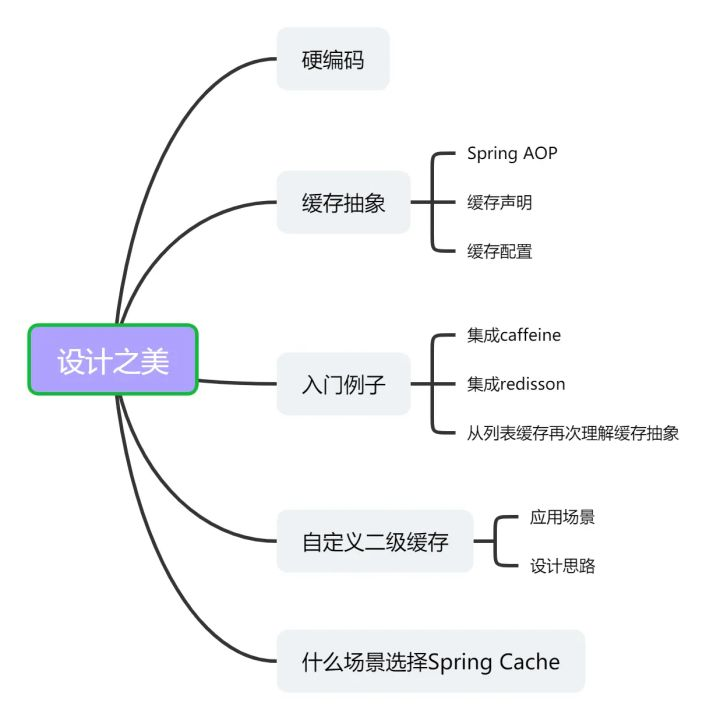
1 硬编码
在学习 Spring Cache 之前,笔者经常会硬编码的方式使用缓存。
举个例子,为了提升用户信息的查询效率,我们对用户信息使用了缓存,示例代码如下:
相信很多同学都写过类似风格的代码,这种风格符合面向过程的编程思维,非常容易理解。但它也有一些缺点:
代码不够优雅。业务逻辑有四个典型动作:存储,读取,修改,删除。每次操作都需要定义缓存 Key ,调用缓存命令的 API,产生较多的重复代码;
缓存操作和业务逻辑之间的代码耦合度高,对业务逻辑有较强的侵入性。
侵入性主要体现如下两点:
开发联调阶段,需要去掉缓存,只能注释或者临时删除缓存操作代码,也容易出错;
某些场景下,需要更换缓存组件,每个缓存组件有自己的 API,更换成本颇高。
2 缓存抽象
首先需要明确一点:Spring Cache 不是一个具体的缓存实现方案,而是一个对缓存使用的抽象(Cache Abstraction)。
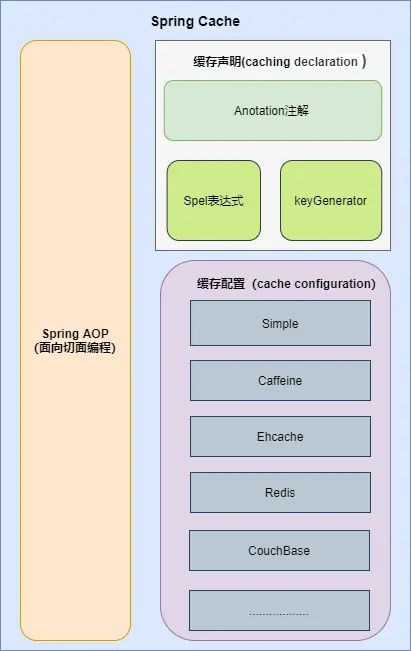
2.1 Spring AOP
Spring AOP 是基于代理模式(proxy-based)。
通常情况下,定义一个对象,调用它的方法的时候,方法是直接被调用的。

将代码做一些调整,pojo 对象的引用修改成代理类。
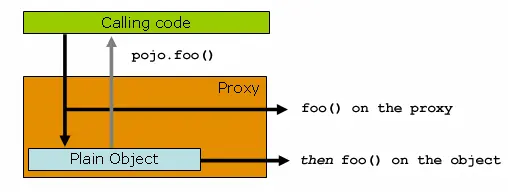
调用 pojo 的 foo 方法的时候,实际上是动态生成的代理类调用 foo 方法。
代理类在方法调用前可以获取方法的参数,当调用方法结束后,可以获取调用该方法的返回值,通过这种方式就可以实现缓存的逻辑。
2.2 缓存声明
缓存声明,也就是标识需要缓存的方法以及缓存策略。
Spring Cache 提供了五个注解。
@Cacheable:根据方法的请求参数对其结果进行缓存,下次同样的参数来执行该方法时可以直接从缓存中获取结果,而不需要再次执行该方法;
@CachePut:根据方法的请求参数对其结果进行缓存,它每次都会触发真实方法的调用;
@CacheEvict:根据一定的条件删除缓存;
@Caching:组合多个缓存注解;
@CacheConfig:类级别共享缓存相关的公共配置。
我们重点讲解:@Cacheable,@CachePut,@CacheEvict 三个核心注解。
2.2.1 @Cacheable 注解
@Cacheble 注解表示这个方法有了缓存的功能。
上面的代码片段里,getUserById 方法和缓存 user_cache 关联起来,若方法返回的 User 对象不为空,则缓存起来。第二次相同参数 userId 调用该方法的时候,直接从缓存中获取数据,并返回。
▍ 缓存 key 的生成
我们都知道,缓存的本质是 key-value 存储模式,每一次方法的调用都需要生成相应的 Key, 才能操作缓存。
通常情况下,@Cacheable 有一个属性 key 可以直接定义缓存 key,开发者可以使用 SpEL 语言定义 key 值。
若没有指定属性 key,缓存抽象提供了 KeyGenerator 来生成 key ,默认的生成器代码见下图:
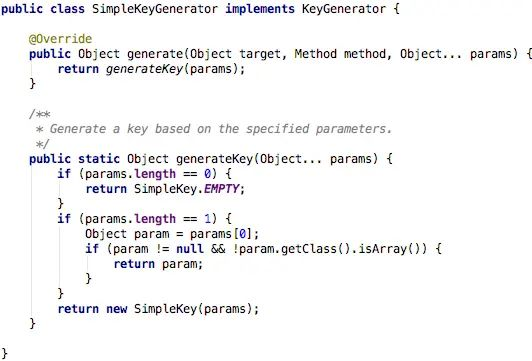
它的算法也很容易理解:
如果没有参数,则直接返回 SimpleKey.EMPTY;
如果只有一个参数,则直接返回该参数;
若有多个参数,则返回包含多个参数的 SimpleKey 对象。
当然 Spring Cache 也考虑到需要自定义 Key 生成方式,需要我们实现 org.springframework.cache.interceptor.KeyGenerator 接口。
然后指定 @Cacheable 的 keyGenerator 属性。
▍ 缓存条件
有的时候,方法执行的结果是否需要缓存,依赖于方法的参数或者方法执行后的返回值。
注解里可以通过 condition 属性,通过 Spel 表达式返回的结果是 true 还是 false 判断是否需要缓存。
上面的代码片段里,当参数的长度小于 32,方法执行的结果才会缓存。
除了 condition,unless 属性也可以决定结果是否缓存,不过是在执行方法后。
上面的代码片段里,当返回的结果为 null 则不缓存。
2.2.2 @CachePut 注解
@CachePut 注解作用于缓存需要被更新的场景,和 @Cacheable 非常相似,但被注解的方法每次都会被执行。
返回值是否会放入缓存,依赖于 condition 和 unless,默认情况下结果会存储到缓存。
当调用 updateUser 方法时,每次方法都会被执行,但是因为 unless 属性每次都是 true,所以并没有将结果缓存。当去掉 unless 属性,则结果会被缓存。
2.2.3 @CacheEvict 注解
@CacheEvict 注解的方法在调用时会从缓存中移除已存储的数据。
当调用 deleteUserById 方法完成后,缓存 key 等于参数 id 的缓存会被删除,而且方法的返回的类型是 Void ,这和 @Cacheable 明显不同。
2.3 缓存配置
Spring Cache 是一个对缓存使用的抽象,它提供了多种存储集成。
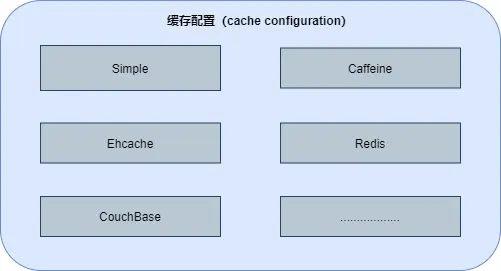
要使用它们,需要简单地声明一个适当的 CacheManager - 一个控制和管理 Cache 的实体。
我们以 Spring Cache 默认的缓存实现 Simple 例子,简单探索下 CacheManager 的机制。
CacheManager 非常简单:
在 CacheConfigurations 配置类中,可以看到不同集成类型有不同的缓存配置类。
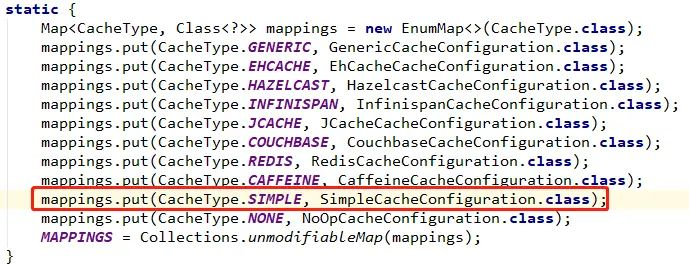
通过 SpringBoot 的自动装配机制,创建 CacheManager 的实现类 ConcurrentMapCacheManager。
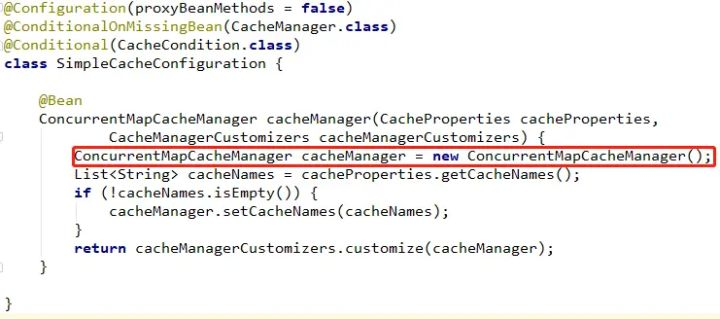
而 ConcurrentMapCacheManager 的 getCache 方法,会创建 ConcurrentCacheMap。
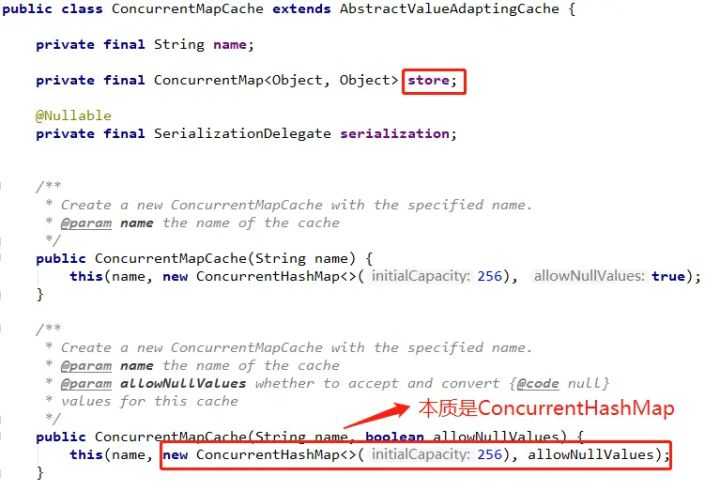
ConcurrentCacheMap 实现了 org.springframework.cache.Cache 接口。
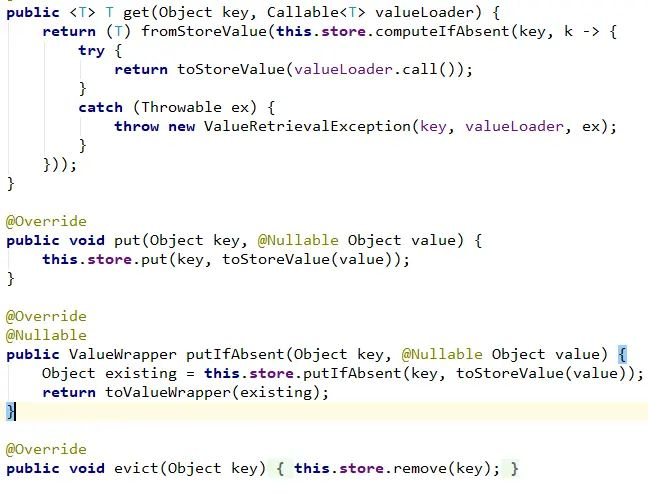
从 Spring Cache 的 Simple 的实现,缓存配置需要实现两个接口:
org.springframework.cache.CacheManager
org.springframework.cache.Cache
3 入门例子
首先我们先创建一个工程 spring-cache-demo。
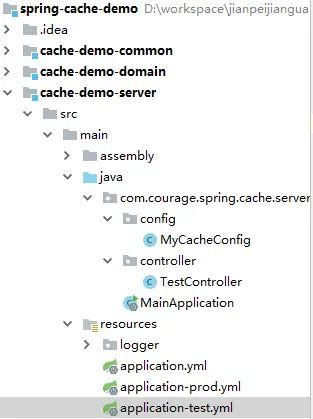
caffeine 和 Redisson 分别是本地内存和分布式缓存 Redis 框架中的佼佼者,我们分别演示如何集成它们。
3.1 集成 caffeine
3.1.1 maven 依赖
3.1.2 Caffeine 缓存配置
我们先创建一个缓存配置类 MyCacheConfig。
首先创建了一个 Caffeine 对象,该对象标识本地缓存的最大数量是 10000 条,每个缓存数据在写入 60 分钟后失效。
另外,MyCacheConfig 类上我们添加了注解:@EnableCaching。
3.1.3 业务代码
根据缓存声明这一节,我们很容易写出如下代码。
这段代码与硬编码里的代码片段明显精简很多。
当我们在 Controller 层调用 getUserById 方法时,调试的时候,配置 mybatis 日志级别为 DEBUG,方便监控方法是否会缓存。
第一次调用会查询数据库,打印相关日志:
第二次调用查询方法的时候,数据库 SQL 日志就没有出现了, 也就说明缓存生效了。
3.2 集成 Redisson
3.2.1 maven 依赖
3.2.2 Redisson 缓存配置
可以看到,从 Caffeine 切换到 Redisson,只需要修改缓存配置类,定义 CacheManager 对象即可。而业务代码并不需要改动。
Controller 层调用 getUserById 方法,用户 ID 为 1 的时候,可以从 Redis Desktop Manager 里看到: 用户信息已被缓存,user_cache 缓存存储是 Hash 数据结构。
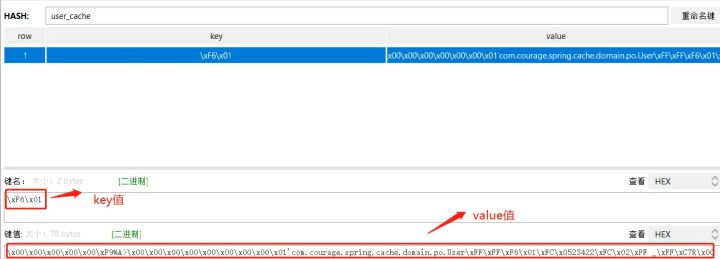
因为 Redisson 默认的编解码是 FstCodec, 可以看到 key 的名称是: \xF6\x01。
在缓存配置代码里,可以修改编解码器。
再次调用 getUserById 方法 ,控制台就变成:
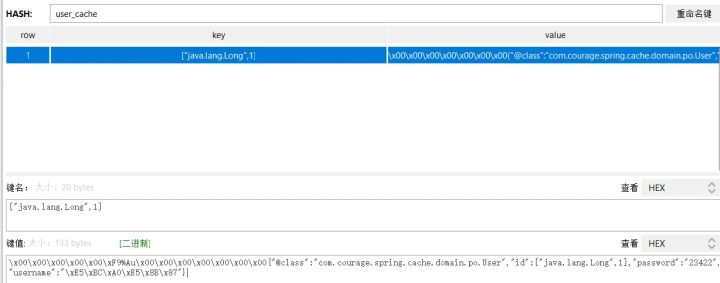
可以观察到:缓存 key 已经变成了:[“java.lang.Long”,1],改变序列化后 key 和 value 已发生了变化。
3.3 从列表缓存再次理解缓存抽象
列表缓存在业务中经常会遇到。通常有两种实现形式:
整体列表缓存;
按照每个条目缓存,通过 redis,memcached 的聚合查询方法批量获取列表,若缓存没有命中,则从数据库重新加载,并放入缓存里。
那么 Spring cache 整合 Redisson 如何缓存列表数据呢?
执行 getUserList 方法,参数 id 列表为:[1,3] 。
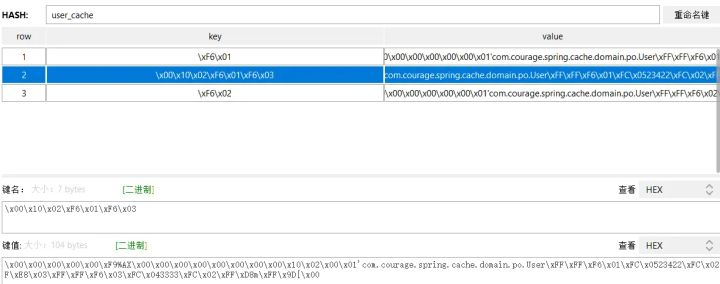
执行完成之后,控制台里可以看到:列表整体直接被缓存起来,用户列表缓存和用户条目缓存并没有共享,他们是平行的关系。
这种情况下,缓存的颗粒度控制也没有那么细致。
类似这样的思考,很多开发者也向 Spring Framework 研发团队提过。
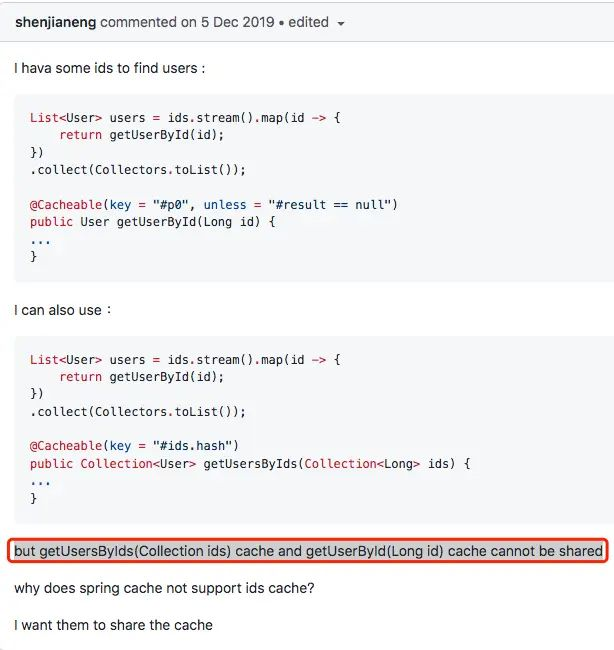

官方的回答也很明确:对于缓存抽象来讲,它并不关心方法返回的数据类型,假如是集合,那么也就意味着需要把集合数据在缓存中保存起来。
还有一位开发者,定义了一个 @CollectionCacheable 注解,并做出了原型,扩展了 Spring Cache 的列表缓存功能。
官方也未采纳,因为缓存抽象并不想引入太多的复杂性。
写到这里,相信大家对缓存抽象有了更进一步的理解。当我们想实现更复杂的缓存功能时,需要对 Spring Cache 做一定程度的扩展。
4 自定义二级缓存
4.1 应用场景
笔者曾经在原来的项目,高并发场景下多次使用多级缓存。多级缓存是一个非常有趣的功能点,值得我们去扩展。
多级缓存有如下优势:
离用户越近,速度越快;
减少分布式缓存查询频率,降低序列化和反序列化的 CPU 消耗;
大幅度减少网络 IO 以及带宽消耗。
进程内缓存做为一级缓存,分布式缓存做为二级缓存,首先从一级缓存中查询,若能查询到数据则直接返回,否则从二级缓存中查询,若二级缓存中可以查询到数据,则回填到一级缓存中,并返回数据。若二级缓存也查询不到,则从数据源中查询,将结果分别回填到一级缓存,二级缓存中。
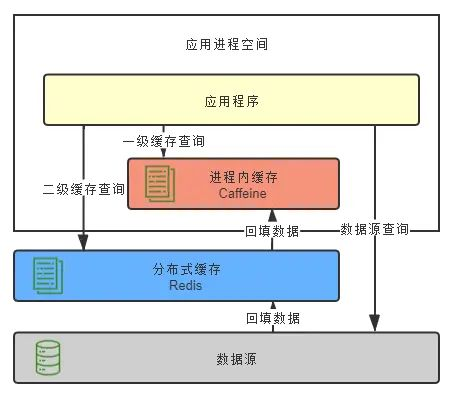
Spring Cache 并没有二级缓存的实现,我们可以实现一个简易的二级缓存 DEMO,加深对技术的理解。
4.2 设计思路
MultiLevelCacheManager:多级缓存管理器;
MultiLevelChannel:封装 Caffeine 和 RedissonClient;
MultiLevelCache:实现 org.springframework.cache.Cache 接口;
MultiLevelCacheConfig:配置缓存过期时间等;
MultiLevelCacheManager 是最核心的类,需要实现 getCache 和 getCacheNames 两个接口。

创建多级缓存,第一级缓存是:Caffeine , 第二级缓存是:Redisson。

二级缓存,为了快速完成 DEMO,我们使用 Redisson 对 Spring Cache 的扩展类 RedissonCache 。它的底层是 RMap,底层存储是 Hash。
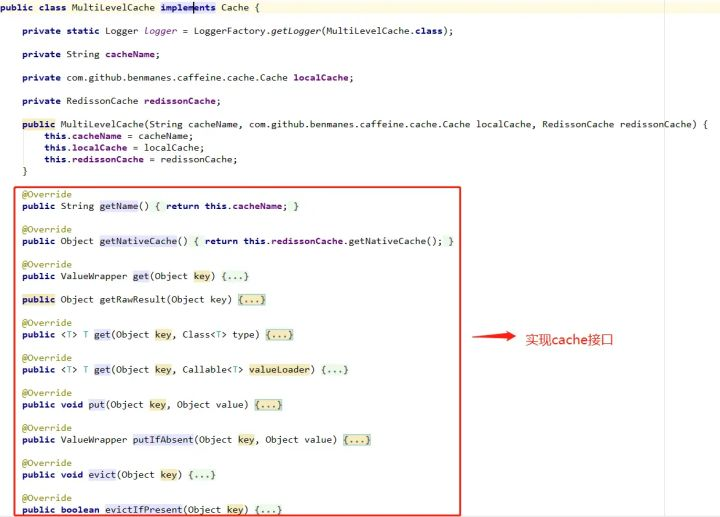
我们重点看下缓存的「查询」和「存储」的方法:
「查询」数据的流程:
先从本地缓存中查询数据,若能查询到,直接返回;
本地缓存查询不到数据,查询分布式缓存,若可以查询出来,回填到本地缓存,并返回;
若分布式缓存查询不到数据,则默认会执行被注解的方法。
下面来看下「存储」的代码:
最后配置缓存管理器,原有的业务代码不变。
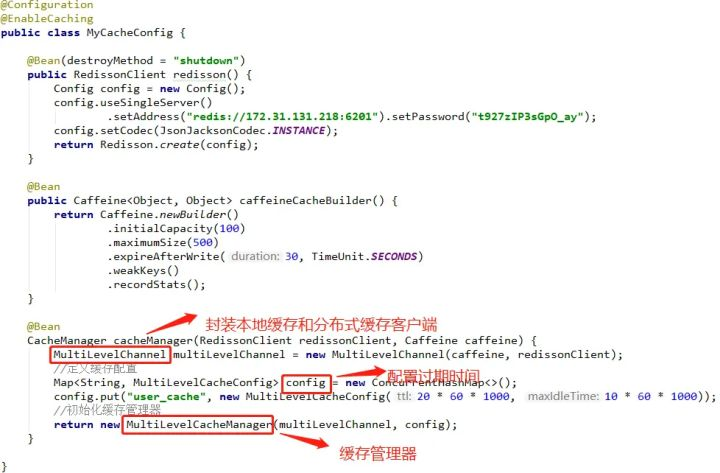
执行下 getUserById 方法,查询用户编号为 1 的用户信息。
第二次执行相同的动作,从日志可用看到从优先会从本地内存中查询出结果。
等待 30s , 再执行一次,因为本地缓存会失效,所以执行的时候会查询二级缓存
一个简易的二级缓存就组装完了。
5 什么场景选择 Spring Cache
在做技术选型的时候,需要针对场景选择不同的技术。
笔者认为 Spring Cache 的功能很强大,设计也非常优雅。特别适合缓存控制没有那么细致的场景。比如门户首页,偏静态展示页面,榜单等等。这些场景的特点是对数据实时性没有那么严格的要求,只需要将数据源缓存下来,过期之后自动刷新即可。这些场景下,Spring Cache 就是神器,能大幅度提升研发效率。
但在高并发大数据量的场景下,精细的缓存颗粒度的控制上,还是需要做功能扩展。
多级缓存;
列表缓存;
缓存变更监听器;
版权声明: 本文为 InfoQ 作者【华为云开发者联盟】的原创文章。
原文链接:【http://xie.infoq.cn/article/f7899a2b0f8d6f48131b74ae6】。文章转载请联系作者。











评论